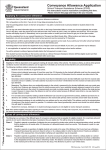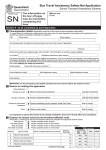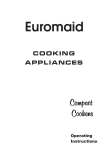Download mains pressure electric water heater
Transcript
COPPERFLOW SERIES MAINS PRESSURE ELECTRIC WATER HEATER INDOOR/OUTDOOR MODEL OWNER & INSTALLER MANUAL AND WARRANTY INFORMATION. PLEASE READ THIS MANUAL CAREFULLY BEFORE INSTALLING AND OPERATING. THIS WATER HEATER MUST BE INSTALLED BY A QUALIFIED PERSON. Manufactured in Australia by Peter Sachs Industries Pty Ltd A.C.N. 010 792 051 A.B.N. 69 010 792 051 Marketed by SAXON SALES FOR SERVICE - CALL 1300 363 959 OR EMAIL [email protected] CONTENTS Page No. ABOUT YOUR HEATER & SERVICE........................................................2 HOW YOUR HEATER WORKS.................................................................5 INSTALLATION DIAGRAMS...................................................................8/9 INSTALLATION........................................................................................10 CONNECTIONS - PLUMBING.................................................................13 CONNECTIONS - ELECTRICAL..............................................................15 SERVICE FAULT CHECK LIST................................................................17 Copyright Peter Sachs Industries Pty. Ltd. © 2009 Document: B710 Issue: 09 Date: July 2009 AUTHORISATIONS: Certificate of Suitability CS/57/Q (Degree of Protection IP23) Standards Australia Watermark AS3498 LIcense No. W191C Tick License No. N1136 1 ABOUT YOUR WATER HEATER AND HOW TO SERVICE IT. Congratulations for choosing a SAXON Electric Mains Pressure Heat Exchange Water Heater. With over 70 years of water heater manufacturing experience, SAXON produces high quality innovative products at affordable prices and is committed to providing excellent sales and service back up. Helpful advice is only a Phone Call away. FOR SERVICE - CALL 1300 363 959 Please quote your Serial Number and Date of Manufacture when telephoning for Service. These are situated on the large decal on the water heater. (SEE FIGURE 1 BELOW) DATE OF MANUFACTURE SERIAL NUMBER FIG. 1 WHAT IS THE LIFE OF A WATER HEATER? The factors which determine water heater life include water quality, water pressure and temperature at which the unit operates and water usage. Your SAXON heater is supported by the Comprehensive Warranty enclosed. 2 HOW TO SAVE UNNECESSARY SERVICE COSTS Follow the Check List below before Calling 1300 363 959. You will be charged for attending to any condition or fault not related to the manufacture of failure of a component part (See Warranty included). SERVICE CHECK LIST FOR ITEMS NOT UNDER WARRANTY 1. Excessive Discharge from Overflow caused by water pressure rising above the pressure designated for your heater. (See ‘Water Pressure’, Page 11) 2. If the Discharge is caused by a faulty valve or a Leak in the heat exchange coil call 1300 363 959 for an inspection. 3. Not enough hot water or no hot water. Check if electricity is switched on at Switchboard and isolating switch if installed at heater. (Look for marking on Switch Board ‘Water Heater’) 4. (a) (b) (c) (d) (e) 5. It is now current practice for most Electricity Supply Authorities to fit a relay in the meter box of new dwellings and frequently in existing dwelling, to control the supply of electricity to the water heater. This is a switch which the Electrical Authority is able to turn on and off by remote control. Adjusting thermostat. Adjusting tempering valve. Checking system controlling relay. Replacing blown fuses - Power not connected. Other unrelated complaints. These relays sometimes malfunction, resulting in a loss of electricity to heat sufficient water to meet household requirements. Relays in new installations are often set for times on and off, which do not suit the occupants and it is possible to have these times altered and malfunctions rectified by contacting your Local Electricity Supply Authority. 6. Is your water heater too small for your requirements? SAXON Sizing Guide literature is available or check website www.saxon.net.au which will help you decide if your water heater is big enough or talk to your Installing Plumber. 3 HOW TO IMPROVE PERFORMANCE 7. If your installation is Borderline, enquire from your plumber about fitting inexpensive flow control valves, water efficient shower roses, low flow tap aerators which will help reduce water usage. Replace leaky tap washers. 8. An option is to adjust the Thermostat upwards to gain additional hot water capacity for limited periods. Avoid setting above 80ºC to reduce the possibility of scalding and reduction of the life of your heater. 9. You may adjust the Flow Rate of the heater. (See ‘Adjusting the Flow Rate’, Page 12). HIGH ELECTRICITY BILLS • Check for excessive flow from Overflow - (See ‘Water Pressure’, Page11) • Check for leaking pipe or dripping tap. A dripping tap at one drip per second wastes over 14,000 litres of water per year, which have paid to heat. • Ask your Plumber to replace any leaking tap washers or other leaks. • Is an outlet such as the shower using more hot water than is necessary? Fit an inexpensive flow control valve. EXCESSIVE STEAM DISCHARGING FROM THE WATER HEATER VENT Adjust thermostat down. If the water heater is boiling, turn off the power to the unit and phone 1300 363 959 or an Accredited Service Agent to arrange for inspection. 4 How Your Water Heater Works A very safe system Water is stored in a copper tank containing a copper heat exchange coil. Water in the tank is heated by an electric heating element. As cold water passes through the heat exchange coil it is heated by the transfer of heat from the hot water in the tank to the cold water in the coil. The mains pressure water in the coil, now hot, is then delivered to taps in the home. Water delivered from a heat exchange system gradually reduces in temperature during the course of prolonged draw off and you will find the need to make small adjustment to the hot and cold taps or your lever mixer to maintain an even flow at the temperature which suits you. After a short time this will become an automatic and unconscious response. This does not mean you are running out of hot water. Mains Pressure The internal copper coil heat exchanger is designed to operate at mains pressure for connection to the mains water supply. If the mains supply pressure in your area exceeds that shown on Page 11 ‘Water Pressure’, a pressure limiting valve must be fitted. Electrical Supply • Continuous electricity supply. This type of supply is required where the unit is operating at maximum capacity. • Off peak or controlled electricity supply. This type of connection will only allow heating to occur during certain set hours and requires larger capacity units. A volume of water sufficient for the day’s total use is heated and stored. This type of supply is more economical. Thermostat The thermostat automatically controls the electricity supply to the heating element, maintaining a constant temperature. The thermostat is mounted inside the junction box cover of the water heaters. Do not switch off the water heater when it is not in use, except for extended periods. The thermostat is fully automatic and only uses power when heating is required. 5 Pressure Relief & Non-Return Valve Situated near the top of the water heater, the pressure relief valve is combined with a non-return valve and is set at 1400kPa. During periods after hot water has been drawn off, water in the coil is trapped between the tap and the non-return valve. This water heats up through the transfer of heat from water in the tank and expands. The relief valve redirects this excess into the tank, assisting with topping non-restricted to provide different flow rates. The pressure relief valve should be checked for performance or replaced at intervals not exceeding 5 years, or more often in areas where water contains hard water deposits (See ‘Topping Up’, Page 7) Vent Pipe The vent pipe must not become blocked or obstructed. It should be checked regularly to ensure it is not blocked. Safety This water heater is protected by a thermostat and a pressure relief valve. Hot water increases the risk of injury by scalding. The water heater is thermostat should be set at the lowest possible temperature which will provide sufficient hot water. The thermostat can be adjusted within the range shown below – Minimum Thermostat Setting of 60ºC Maximum Allowable Thermostat Setting of 80ºC We recommend, and it may also be required by some Councils, that an approved temperature limiting device be fitted into the hot water piping to bathrooms. This will keep the water temperature below 50ºC at the bathrooms. Risk of scald injury will be reduced, whilst providing hotter water to the kitchen and laundry. 6 Topping Up Once every six months the pressure relief valve must be checked by the owner. To top up the tank and check the valve, lift the valve lever against the spring pressure until water flows from the overflow pipe. When water flows from the overflow, restore the lever to its original position. (Do not let the lever snap back, as this may damage the valve seat). As cold water is introduced into the tank, it will expand and continue to flow for some time. It is good idea to do this check whenever you receive your electricity bill. If water does not flow freely call the SAXON Service Number or the local SAXON Accredited Service Agent. Lift the lever upwardly against the spring tension combination expansion relief, non-return, filler valve FIG. 2 7 Internal temperature control The internally adjustable thermostat may be altered by removing the junction box cover. This adjustment must be made by a qualified service person. Adjusting flow rate If you need to adjust the flow rate of the water heater see Page 12 for more detail. Correcting the flow rate will provide best possible performance. Installation diagrams 8 Installation diagrams Use to adjust flow rate as per SAXON installation instructions When fitting Tempering Valve at the water heater, ensure the cold supply to the Tempering Valve is teed off the cold supply to the water heater down stream from the isolating stopcock and any pressure limiting valve (if fitted) Isolating Stopcock Line Strainer (advisory) Downward Heat Trap (advisory) Cold Water Supply Pressure Limiting Valve (if required) Tempered Water Outlet (to Bathrooms) Adjustment of Tempering Valve Temperature See valve manufacturer’s instructions for details. Junction Box Cover Full Hot Water Outlet (to Kitchen) Use this outlet to measure flow rate NOTE: For optimum performance or when fitting Tempering Valve remote from water heater, use RMC Heatguard HP Tempering Valve (green knob) or similar. 9 Installation installation Installation of this water heater must be performed by an Authorised Person and in accordance with both Local Authority Regulations and AS/NZS 3500.4 “National Plumbing and Drainage Code and AS/NZS 3000. Wiring Rules. Location Install as close as practicable to the kitchen or most frequently used hot water outlet in an accessible position, and with adequate access to thermostat and element at front of heater. Do not completely enclose unit – it is essential that it be readily removable for servicing. Clearances Allow adequate room to work with tools. A minimum of 25mm clearance all around the water heater including the top is required. An additional 30mm is required for relief valve removal, 80mm for access cover removal and 400mm for element removal. You should be able to read the information on the rating plate. Adequate provision must be made to dispose of any escape of water from heater or adjacent plumbing which might result in damage to property. The water heater must be connected in such a way that the electrical junction box is accessible to a service agent allowing the removal of the heating element and for complete removal of the unit when necessary. FIG. 4 Confined Spaces If the thermostat fails the unit may produce excessive steam. It is strongly recommended that heater should be installed in well ventilated spaces to avoid condensation build up. If installed in confined areas, make provision for Service Access. Vent safely to open air and carry overflow to drain. 10 Foundation To ensure adequate ventilation, position unit on a timber support base on a concrete slab. (See Figure 5) FIG. 5 Alternative forms of water heater bases are acceptable providing they allow for adequate ventilation. Attention is drawn to the weight of the water heater when full and installer should ensure that the base and footings are substantial enough to avoid subsidence etc. Safe tray It is a requirement of the National Plumbing Code AS/NZS 3500.4 that all water heaters be installed in a safe tray, where in the event of a leak, property may otherwise be damaged. Installation of safe trays must comply with clause 4.4 and sub clause 1 to 5 of the abovementioned Code. Water pressure Test Incoming Water Pressure with a gauge. If pressure exceeds 1100kPa, an approved pressure limiting valve is required and should be fitted as shown in the installation diagram. (Page 9) Pressure limiting Valves are not supplied with Water Heaters. Tank Supply Not recommended without a pressure pump, minimum supply pressure should be no less than 350kPa. A non-restricted HPNR valve may be required to be fitted for supply less than 350kPa. 11 Bore Water Supply NOT RECOMMENDED FOR CONNECTION. For further information contact SAXON Service. If the heater is connected to bore supply against SAXON recommendation, warranty does not apply. Vent Pipe This Pipe Must Not Become Blocked or Obstructed. It should be checked periodically to ensure it remains clear. To prevent accidental discharge of hot water through the vent pipe whilst checking the valve, the vent pipe may be extended downwardly. (See Connections Plumbing ‘Vent Pipe’, Page 13) Adjusting Flow Rate Failure to operate the water heater at the correct recommended flow rate could result in unsatisfactory hot water delivery. The best flow rate to heat water to the required temperature is 9 litres/minute for the 140 litre model. For the 70 litre, 90 litre and 140 litre model, a flow rate in excess of 9 litres/minute is not recommended. A flow rate up to 12 litres/minute can be set for the 180, 280 and 400 litre units if desired. To adjust the flow rate: • • • • • The cold water supply should be turned off at the stopcock which is situated on the cold water inlet side of the unit. Position an average household bucket of 9 litres under the laundry hot tap. Turn the tap fully on and note how long it takes to fill the bucket. A 9 litre bucket should fill in 1 minute for 9 litre/minute or 45 seconds for 12 litres/minute. Should the bucket not be filled or overflow in this time, the flow rate can be adjusted by adjusting the water heater isolating the stopcock. Repeat this procedure until the desired rate is achieved. Hot water Delivery As this water heater delivers water hotter than 50ºC, a temperature control device is recommended to be fitted, at the water heater (See illustration, tempering valve, Page 9) between the water heater and outlets in bathrooms and en suites. Reducing Heat Losses To reduce heat loss, it is recommended weatherproof insulation be applied to the first 1.5 to 2m of the hot water line out of the water heater. Heat Trap A heat trap should be inserted in the hot water supply line. See diagram on Page 8. Refer to National Plumbing Code AS/NZS 3500.4. 12 Connections - Plumbing All Plumbing Connections should be made in accordance with appropriate Local Authority Regulations. Flush out pipes before connecting unit to ensure that no foreign matter blocks the valve seating. Use Line strainers where required by Local Authority. It is recommended that Connections should be made with compression fittings – under no circumstances should any connections in the installation be welded, brazed or soldered. Provided flare annealing and the use of hammer type flaring tools are not used, crox or flare connections may be used. Connection sizes • • • • Hot Water Connection: DN115 Copper Tube Cold Water Connection: BSP Male suitable for compression joint. Vent Pipe: 12.7mm Copper Tube DN15 Copper Tube. Overflow 19.1mm Copper Tube DN20 Copper Tube. Prize Sizes For best results, choose the most suitable pipe size for each application. Allow for the cold water piping to the water heater to be the same size or larger than the hot water line from the water heater. Inlet/Outlet connection On the cold water inlet connection, carefully follow the installation diagram (See Page 8 and 9). Always provide a union connection at the inlet and outlet on the water heater to allow for disconnection of the water heater. Vent Pipe The vent pipe must not become blocked or obstructed. It should be checked regularly to ensure it remains clear. The vent pipe may be extended downwardly a distance not exceeding 1 metre, in the event of accidental discharge of hot water through the vent pipe whilst checking the relief valve. To prevent the possibility of collapsing the tank by creating a vacuum, a 3mm hole should be drilled into the top of the elbow attached to the vent pipe. The vent pipe should discharge at a visible point where water flow will not cause damage to property or injury to persons. Note: Thermostats above 80ºC will cause normal wafting steam which will condense and drip from the vent pipe. (See Installation in ‘Confined Spaces’, Page 10) 13 OVERFLOW PIPE Overflow pipes may be extended from the water heater, but must not be less than 19.1mm (¾”) O.D. copper tube – not more than 10 metres in length. Right angled bends must be limited to no more than three. The extension must fall from the overflow outlet, should not be looped, and shall discharge at a visible point where water flow will not cause damage to property or injury to persons. This Pipe Must Not Become Blocked Or Obstructed. Filling the Water Heater by lifting the Valve Lever N.B. – Turning on the Stopcock or Duo Valve alone does not fill the heater. Power must not be turned on until the water heater is filled with water, and a satisfactory megger reading is obtained. Open the cold water isolating stopcock to the water heater. Operate the lever on the combination pressure relief and non-return valve. This allows the water to bypass the valve and fill the main tank. Water will flow from the overflow when the tank is full. Draining the Water Heater Turn the power off. Turn off the cold water supply to the heater. Check that vent and overflow pipes are unobstructed to avoid collapsing the tank. To drain the tank, remove the drain plug and attach a hose to the water heater. Rake the other end of the hose to a Drain. 14 Connections – Electrical Power must not be turned on until the water heater is filled with water, and a satisfactory megger reading is obtained. (See ‘Filling the Heater’, Page 14) All water heaters are designed for 230-240V a.c. mains operation. Electrical connections are made at the terminal block (access to which is made by removing the junction box cover from the front of the heater). 1. Check all connections for wires which may have worked loose in transit. 2. Check thermostat setting before replacing junction Box Cover. Normal thermostat setting is 80ºC. Caution: Take care when drilling into external case for saddles or clips used to mount plumbing and electrical fittings. Do not penetrate more than 12mm. Heating Element The water heater is fitted with an incoloy bolt-on immersion type element. There are several different element ratings used throughout the SAXON range of water heaters. The rating of your element is shown on the main decal (See Fig. 1) and will be one of the following:(i) 1.8kW (ii) 2.4kW (iii) 3.6kW (iv) 4.8 kW The standard element will make a rumbling sound under normal operating conditions, similar to the sound of an electric jug heating water. This sound in itself does not indicate that the unit is boiling. If you consider this noise to be unacceptable, some possible solutions are:(1) Changeover existing element with non-standard lower density heating element of the same wattage. (2) Relocate Water Heater. 15 Plastic Piping and Hot Water Under normal operating conditions, electric water heaters may heat water to around 80ºC. Mains pressure varies from location to location and from time to time and SAXON electric water heaters are fitted with an expansion relief valve rated at 1400kPa. Under certain circumstances such as component malfunction, temperatures of water may exceed 80ºC at pressures up to 1400kPa. Tradesmen must ensure that the plastic pipe they are using complies with relevant standards and can handle both the temperatures and the pressures associated with water heaters in both normal operating conditions and in times of component malfunction for the life of the installation within the property. Tradesmen should reference AS/NZS 3500.4 to ensure that they use the correct plastic pipe for the particular task. Pipe manufacturers may also provide additional information. Water Quality SAXON water heaters have been manufactured to suit most Australian water supplies. However, some water supplies can have a detrimental effect on the copper inside the SAXON water heater. Water chemistry from some water authorities and in some shires may, from time to time, result in pitting corrosion of the copper coil and ultimate failure of the water heater. Some SAXON water heaters are fitted with a small anode to assist in the prevention of pitting corrosion due to water which is corrosive to copper. Key know contributors to pitting corrosion include pH levels below 7 and/or bicarbonate to sulphate ratios in the water of less than 2:1 ratio. If you are unsure of your water quality, you can obtain information from your local council or local laboratories. Installing a SAXON water heater in areas where water that is corrosive to copper exists may void your warranty. 16 Service fault checklist COMPLAINT SUSPECTED CAUSE TO CORRECT PROBLEM Poor Water Pressure Blockage at the inlet connection Re-adjust isolating valve Disconnect the water supply at the valve to remove blockage Fit unrestricted HPNR valve Not Heating (a) Tripped Circuit Breaker (b) Faulty thermostat or heating element Reset Circuit Breaker Call SAXON Service to replace parts if in warranty period - if out of warranty, call electrician Call Electrician Switch unit on Contact Locate Electricity Authority (c) Fuse Wire broken (d) Unit switched off (e) Faulty control relay Insufficient Hot Water Phone Electrical Authority to change tariff (a) Unit connected to wrong electricity tariff (b) Unit leaking (c) Water passing through too quickly (d) (e) (f) Water level in storage cylinder below desired level Tempering valve setting on low Thermostat setting too low Call SAXON Service to repair unit if under warranty Adjust flow rates to recommended setting (See Page 12) Refer Valve Maintenance (See Page 6) Call Plumber Call Electrician Overflowing (if in excess of 250ml per day) (a) Faulty Valve Steam issuing from unit Unit boiling (a) (b) (c) Rumbling Sound Heating (element) Rumbling sound occurs during normal heating cycle. If noise is excessive (See ‘Heating Element’, Page 15) Loud banging noise in or near heater Water hammer (a) Adjust flow rate to recommended settings (b) Call SAXON service Electricity account too high Leaking pipe or dripping tap boiling Check for leaks See above (Unit Boiling) (b) Mains water supply in excess of 1100kPa (c) Leaking coil If under warranty-contact SAXON service Outside of warranty contact local plumber Install pressure limiting valve in cold water line before HPNR valve (500-600 kPa) Call SAXON service or local plumber/ electrician Adjust thermostat down Replace thermostat - if under warranty call SAXON service Contact local electrician saxon service - phone 1300 363 959 17 SERVICE 1300 363 959 MANUFACTURED IN AUSTRALIA BY PETER SACHS INDUSTRIES PTY LTD MARKETED BY SAXON SALES Peter Sachs Industries Pty Ltd Zillmere Brisbane 4034 Phone (07) 3265 5133 Fax (07) 3265 5781 A.C.N. 010 792 051 NOTE: Every care has been taken to ensure the accuracy in preparing this publication. No liability can be accepted for any consequences which may arise as a result of its application.


























